Best
Grand Piano
-
Overall: Use At Home Or In Small Performance Spaces
-
Best Feature: Utilises 3 Pedals For Full Sostenuto. Made From High-Quality Materials
-
TedScore™: 9/10
Best
Upright Piano
-
Overall: High-Quality Materials Used Throughout The Production Process
-
Best Feature: Attractive Design With A 48" Height And 59" Width
-
TedScore™: 10/10
Best
Piano for Beginners
-
Overall: Built-In Yamaha CFX Concert Grand Piano Sound
-
Best Feature: A Graded Hammer Standard (GHS) Keyboard With Matte Keytops
-
TedScore™: 9/10
Wondering whether to bring home an upright piano or a grand piano? For a music enthusiast like you, this choice might seem as tricky as deciphering sheet music. Relax, the answer is within reach.
An upright piano is perfect for those who have limited space. It’s also a great quality instrument for beginners because of its affordable price. Its compact size may give the impression that it’s not as impressive as its baby grand piano and cousin. However, it can still produce beautiful sounds that can fill the room.
On the other hand, if you have enough space and budget, a grand piano is the way to go. Its larger size allows for more string length, which results in a richer and fuller sound. Plus, it can add a touch of elegance to any room it’s placed in.
Want to learn more? Let’s dive into the differences between the two and find out which suits your musical style better!
The Similarities Between Upright And Grand Pianos
When it comes to acoustic pianos, there are two main types: upright and grand pianos. While they may differ in size, shape and design, they share some similarities.

Strings and Soundboard
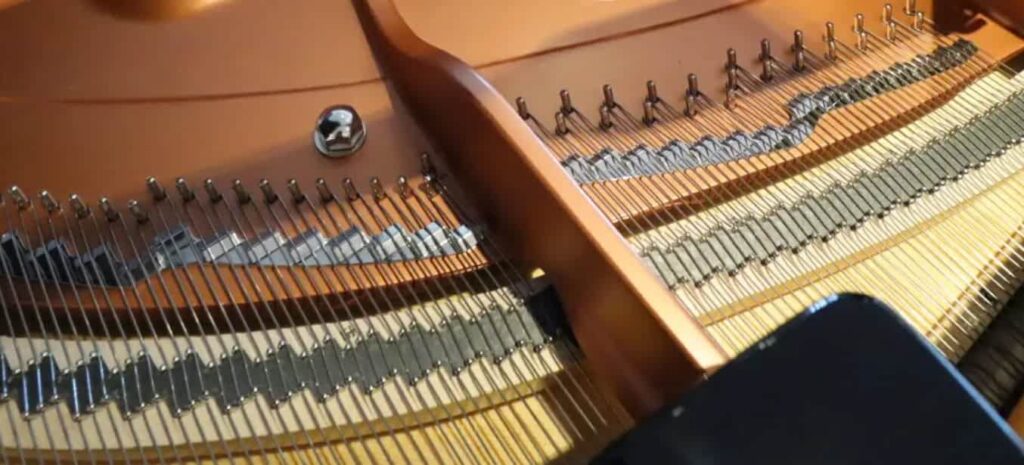
Both upright and grand pianos have strings and a soundboard. The strings are stretched across the soundboard and produce sound when struck by hammers. The soundboard amplifies the sound and projects it outwards. The materials used for the strings and soundboard can affect the tone and of the piano.
Action and Touch
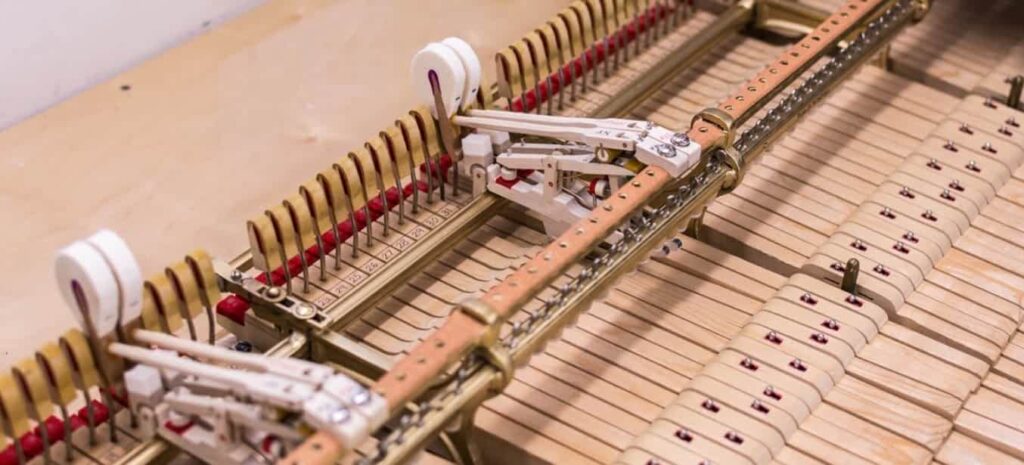
The action mechanism in both upright and grand pianos is similar. A hammer strikes a string when a key is pressed, producing a sound. The touch of the keys and pedals can also be similar. However, the touch and feel of a piano can vary depending on the brand, model, and age.
Dynamic Range
Upright and grand pianos both have a dynamic range, which is the difference between the softest and loudest sounds the piano can produce. The materials used and the piano’s design can affect the dynamic range.
Pedal
Both upright and grand pianos have three pedals: the sustain pedal, the soft pedal, and the sostenuto pedal.
The sustain pedal sustains the sound of the notes played, the soft pedal softens the sound, and the sostenuto pedal sustains only the notes pressed down when the pedal is engaged.
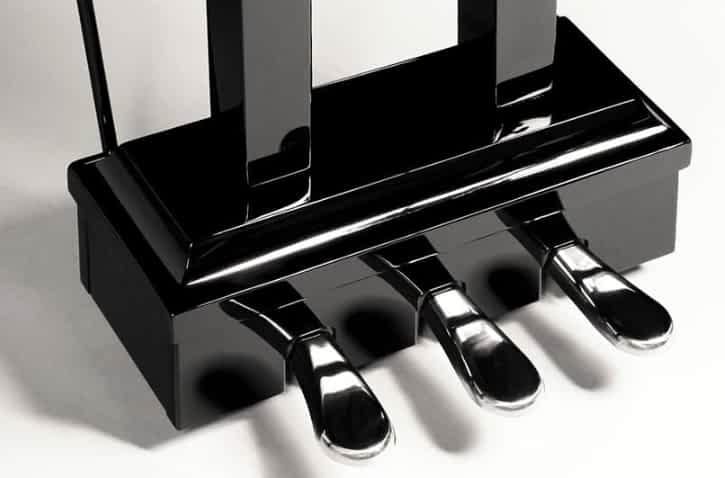
Space, Size, and Material
Upright pianos are designed to take up less space than grand pianos.
They’re taller than they are wide and can fit in smaller rooms. Grand pianos, however, are wider than tall and require more space.
However, both pianos can be used in various settings, from home to studio to concert hall.
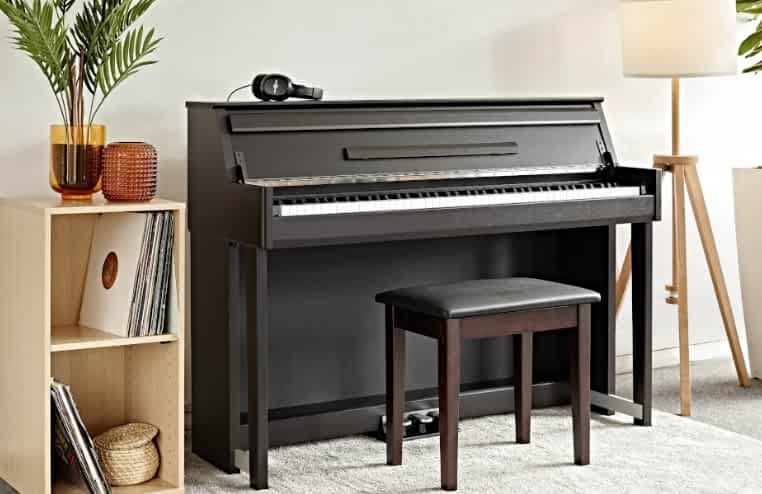
Both upright and grand pianos can be made from various materials, including wood, metal, and plastic. The materials used can affect the tone and volume of the piano.
The Differences Between Upright And Grand Piano
Build and Look
One of the most obvious differences between upright and grand pianos is their shape and size. Grand pianos have a horizontal frame and a larger soundboard, while are vertical and more compact. This difference in construction affects the instrument’s overall sound quality and projection.
Grand pianos are often seen as more visually impressive due to their larger size and elegant shape, while upright pianos are more practical for those with limited space.
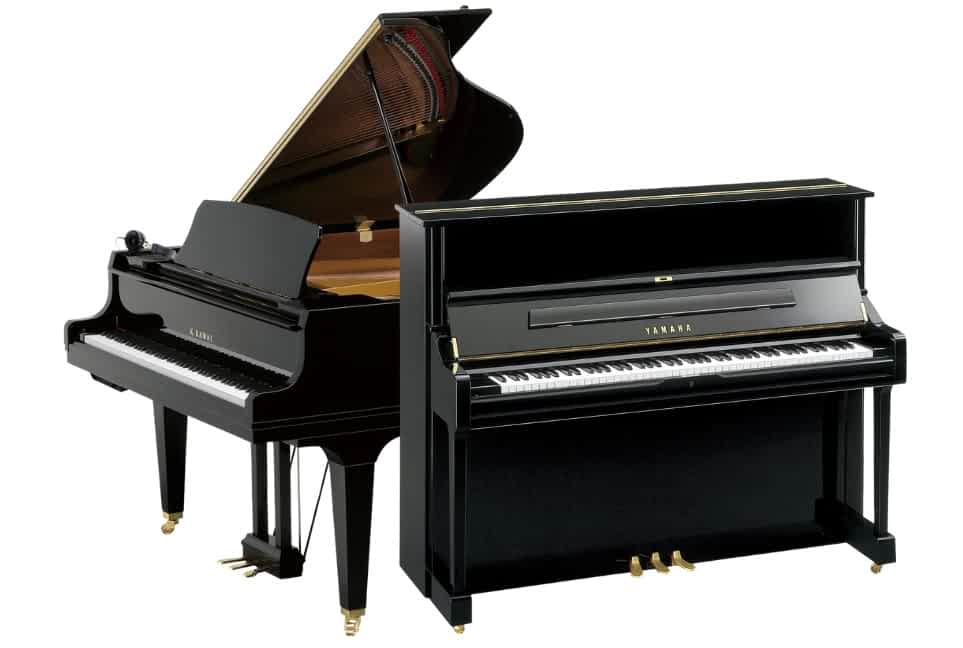
Action
Another major difference is the action mechanism. Grand pianos have longer strings and a more refined action, allowing for faster key repetition and greater control over dynamics and expression.
On the other hand, Upright pianos have a vertical action mechanism that can feel heavier and less responsive. This can make it more challenging for beginners or advanced players to perform trills and other fast passages easily.
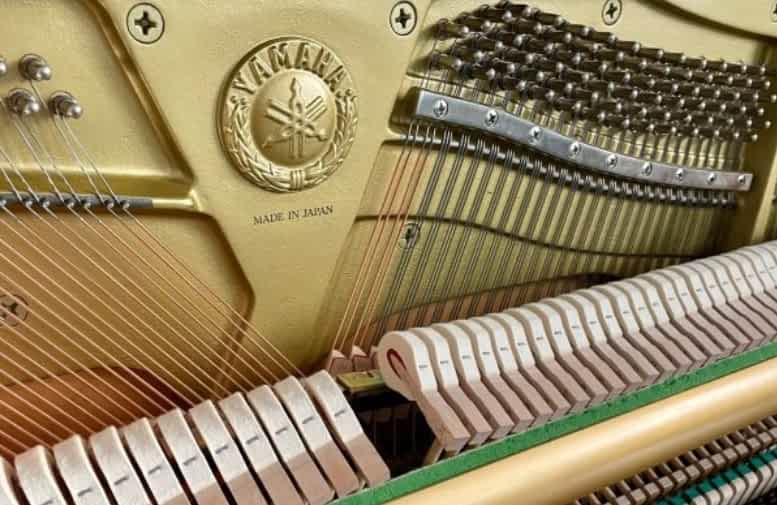
Pedal
Both types of pianos have three pedals: the sustain pedal, the soft pedal, and the una corda pedal.
However, grand pianos also have a sostenuto pedal, which allows for the selective sustaining of specific notes.
The shift pedal on a grand piano allows the player to shift the entire keyboard to the right or left, providing greater flexibility in playing certain pieces.

Other Differences
There are several other differences between and grand pianos to consider. Grand pianos often have a richer, resonant sound due to their larger soundboard and longer strings. On the other hand, Upright pianos may have a more compact sound with less overall projection.
Grand pianos are also more expensive due to their larger size and higher quality craftsmanship. However, some high-end upright pianos can rival the quality of a grand piano.
Benefits Of Playing Grand Pianos
You may want to consider playing a grand piano if you’re an advanced piano player. Grand pianos offer several benefits that can improve your playing experience. Here are some of the benefits of playing pianos:
Tone and Touch
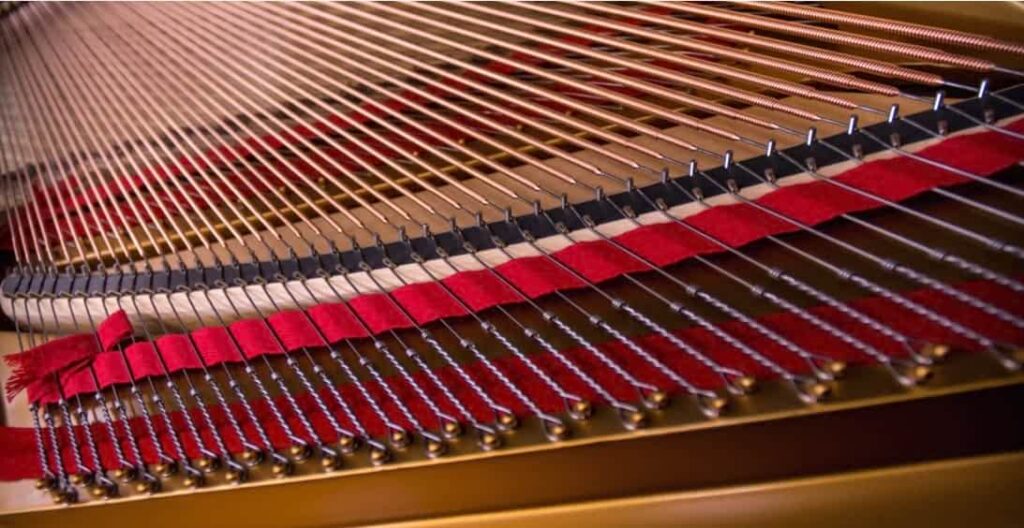
Grand pianos have a richer and more complex tone than upright pianos. The horizontal position of the strings in a grand piano allows for longer strings, which produce a more resonant and sustained sound. This makes grand pianos ideal for playing classical music, where tone quality is crucial.
These pianos have a more responsive touch than upright pianos. The action mechanism of a grand piano is more complex, allowing for greater control and precision in playing. This allows it to play fast and intricate pieces.
Resonance and Dynamic Range
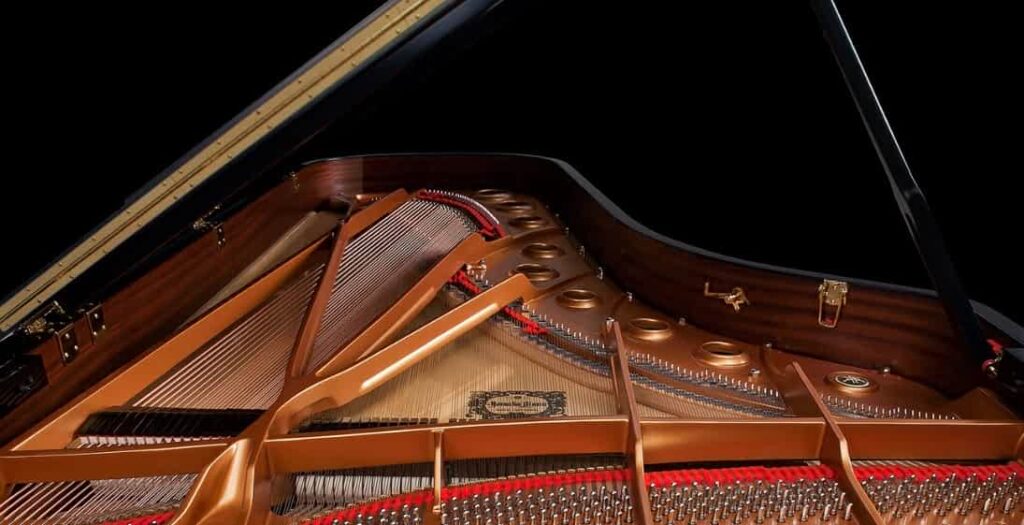
Grand pianos have a more resonant sound than upright pianos. The soundboard of a grand piano is larger and more flexible, allowing for greater resonance and sustain. This makes grand pianos ideal for playing romantic and impressionistic music, where resonance is important.
These have a wider dynamic range than upright pianos. The longer strings and larger soundboard of a grand piano allow for greater variation in volume, from the softest pianissimo to the loudest fortissimo.
Projection and Consistency
Grand pianos have better projection than upright pianos. The horizontal position of the strings in a grand piano allows for better sound projection, making the sound more audible in large concert halls. This makes grand pianos ideal for performing in large venues.
They’re more consistent than upright pianos. The action mechanism of a grand piano is more stable and less affected by changes in temperature and humidity, ensuring consistent performance over time. They’re also perfect for recording studios and concert halls, where consistency is important.
Dampers
Grand pianos utilize better damper mechanisms than upright pianos. The dampers in a grand piano are more precise and responsive, allowing for greater control over sustain and resonance. They’re ideal for playing music that requires precise control over damping.
Our Recommended Grand Piano: YAMAHA C3X PE
This piano is part of Yamaha’s CX series, designed to create instruments that truly sing. The C3X features a thickened back frame for improved support, resulting in a rich and resonant tone. Its soundboard resonates with the performer’s emotions, and its revolutionary new music wire offers beautiful sustain and harmony. With its amazing sound and high-quality materials, the Yamaha C3X piano will last a lifetime and make any pianist happy.
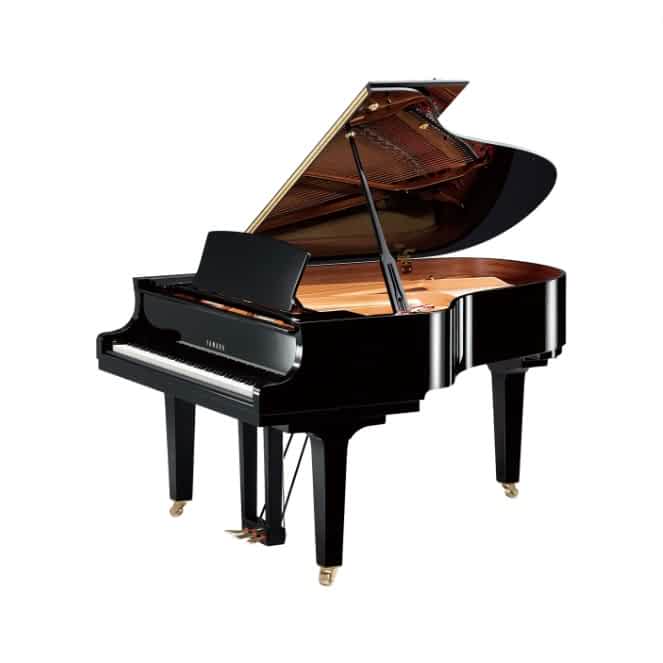
PERFECT FOR: use at home or in small performance spaces
FEATURES: Utilises 3 pedals for full sostenuto
OTHER INFO: Made from high-quality materials
Yamaha C3X PE Grand Piano
When you check the price above, you’ll see there are loads of great places to buy this item. Our personal favorite is Gear4music.
It is the largest music retailer in the UK and fast becoming the most respected online music shop in the US too. Their customer service is excellent, they have competitive prices, really fast shipping, and usually have the longest guarantee.
Most professional musicians use Gear4music, so there is no reason why you shouldn’t too!
- With a length of 186 cm
- Produces beautiful, rich tones
- Available in a range of letters and models (G3, C3, C3X)
- An amazing sound that will make any pianist happy
- A piano that will last a lifetime
- Expensive piano - one of Yamaha's top-tier pianos
The professional musician who wrote this article combined many things,
from the product build, manufacturer’s reputation through to feedback
from other users, to create our famous TedScore™.
Benefits Of Playing Upright Pianos
Compact Shape and Weighted Keys
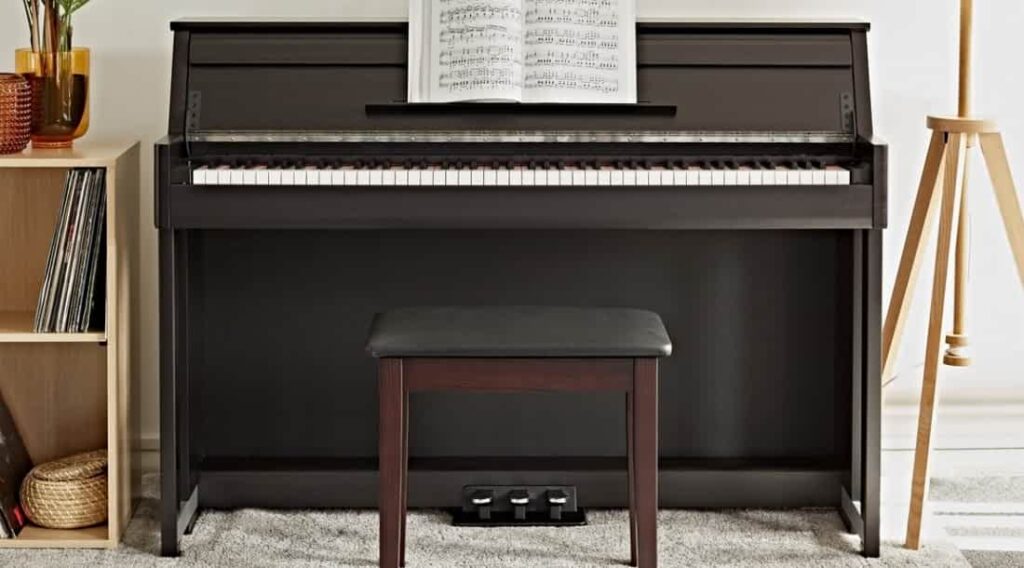
One of the biggest advantages of an upright piano is its compact shape. Unlike grand pianos, upright pianos take up less space, making them ideal for smaller homes, apartments, or studios. This also means that an upright piano is easier to move around, making it a great option for gigging musicians.
Upright pianos come with weighted keys that mimic the feel of a grand piano. This means you can practice on an upright piano and still develop the finger strength and technique you need to play a grand piano. Weighted piano keys also make it easier to control the dynamics of your playing.
Sustain
While grand pianos may have a longer sustain, modern upright pianos have improved in this area and can now produce a quality sound with a decent sustain. Additionally, upright pianos can produce a more even sound across all registers, making them ideal for playing a wide range of music.
Tone Quality
While grand pianos may have a richer tone quality, modern upright pianos have improved in this area and can now produce a sound comparable to a grand piano. Additionally, upright pianos can produce a more even sound across all registers, making them ideal for playing a wide range of music.
Ideal for Schools and Beginners
Upright pianos are a great option for schools and music studios. They are less expensive than grand pianos, making them a more affordable option for educational institutions. Additionally, their compact shape makes them easier to fit into classrooms or practice rooms.
An upright piano may be your best option if you’re a beginner. Upright pianos are generally less expensive than grand pianos, making them a more affordable option for those just starting out.

An upright piano’s compact shape means you can practice in a smaller space without sacrificing sound quality.
In conclusion, upright pianos are a great option for those looking for a more affordable and compact piano without sacrificing sound quality. Whether you are a beginner or an experienced pianist, an upright piano can provide you with the sound and feel you need to take your playing to the next level.
Our Recommended Upright Piano: YAMAHA u1 UPRIGHT PIANO
The U1 is built exceptionally well with high-quality Japanese manufacturing and has a versatile sound suitable for classical music, jazz, pop and more. It has a rich and resonant tone, with precise and accurate action. While newer models can be quite expensive, the Yamaha U1 holds its value exceptionally well, and many very old models on the used market are still going strong. It’s a firm favourite with piano and instrumental teachers due to its smaller size that fits neatly into small spaces.
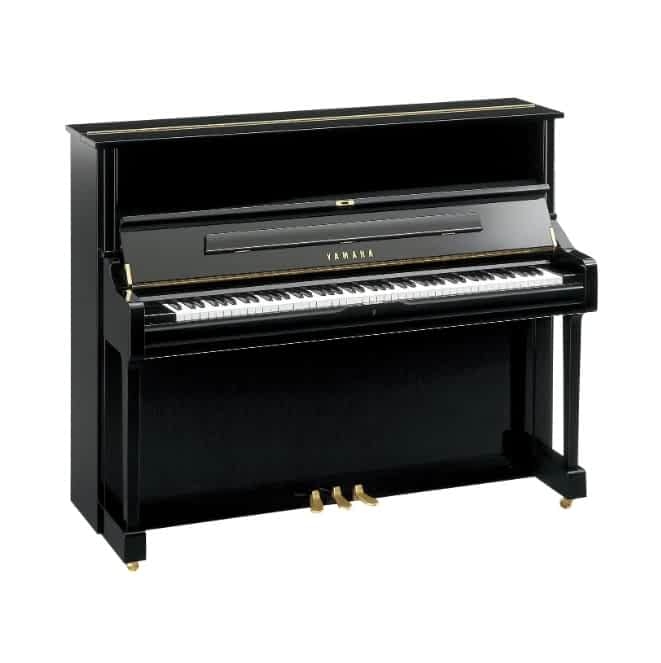
PERFECT FOR: beginners to professional pianists
FEATURES: Attractive design with a 48" height and 59" width
OTHER INFO: High-quality materials used throughout the production process
Yamaha U1 Upright Piano
When you check the price above, you’ll see there are loads of great places to buy this item. Our personal favorite is Gear4music.
It is the largest music retailer in the UK and fast becoming the most respected online music shop in the US too. Their customer service is excellent, they have competitive prices, really fast shipping, and usually have the longest guarantee.
Most professional musicians use Gear4music, so there is no reason why you shouldn’t too!
- Light play action is designed to prevent hand fatigue and encourage practice time
- Offers a nice tonal balance across the entire keyboard, with all 88 notes complementing each other
- Provides amazing sound quality that continues throughout the years of proper maintenance and care
- Affordably priced within its class and offers great resale value
- Designed for studio-type spaces - may not fill larger rooms with sound as well as the larger U3 upright piano
The professional musician who wrote this article combined many things,
from the product build, manufacturer’s reputation through to feedback
from other users, to create our famous TedScore™.
Upright Piano vs Grand Piano
Summary
Choosing between an upright piano and a grand piano is a matter of personal preference and needs. Upright pianos are more affordable, take up less space, and are great for beginners or those with limited space. On the other hand, grand pianos offer a more expressive and dynamic sound, making them ideal for professional pianists or those who want to make a statement with their instruments.
When deciding which type of piano to buy, it’s essential to consider your budget, space, and playing style. If you’re starting, a piano and an upright piano will be perfect for you. A grand piano is the way to go if you’re an experienced pianist or want a piano that will last for generations.
I hope this article has provided valuable insights into the differences between upright and grand pianos and helped you make an informed decision!
Remember, whatever your choice, investing in a high-quality piano that will bring you joy and inspiration for years to come is essential. So go ahead, tickle those ivories, and make beautiful music!
But, before that…
If you’re still looking to buy a piano, our comprehensive piano lessons guide has covered everything you need to know to pick the perfect instrument! Let’s find your dream piano together in this next article!
FAQ's
While grand pianos generally offer superior sound quality and control, they can also be more expensive and take up more space. On the other hand, upright pianos are more practical for smaller spaces and budgets and can still provide excellent sound quality for most players.
Yes, upright pianos and grand pianos do sound different. This is due to significant difference in the size and orientation of the strings and the vibrating surface of the wooden soundboard, which are larger and longer in grand pianos.
No, grand pianos are not inherently harder to play than upright pianos. Both should feel comfortable to play, but there is one aspect of the grand piano touch that is superior – evenness. The longer keys on grand pianos allow for less variation in touch from front to back, making it easier to play with consistency.
The main difference is that a grand piano action uses gravity as its main driving force, while an upright piano action is operated by a series of springs that essentially ‘fling’ the hammer forwards, striking the strings. This affects the level of repetition and accuracy of the instrument and the size and evenness of touch.


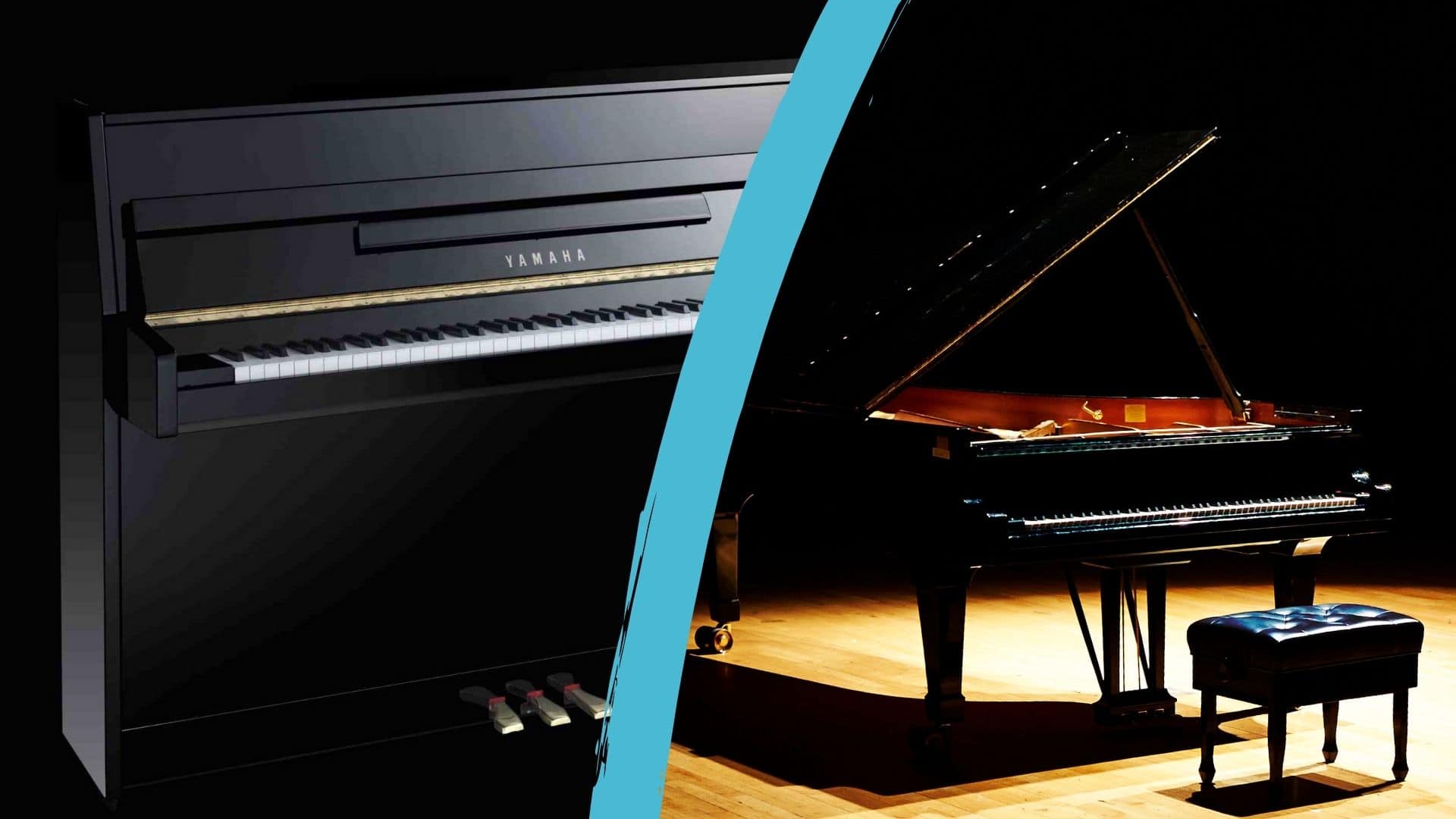







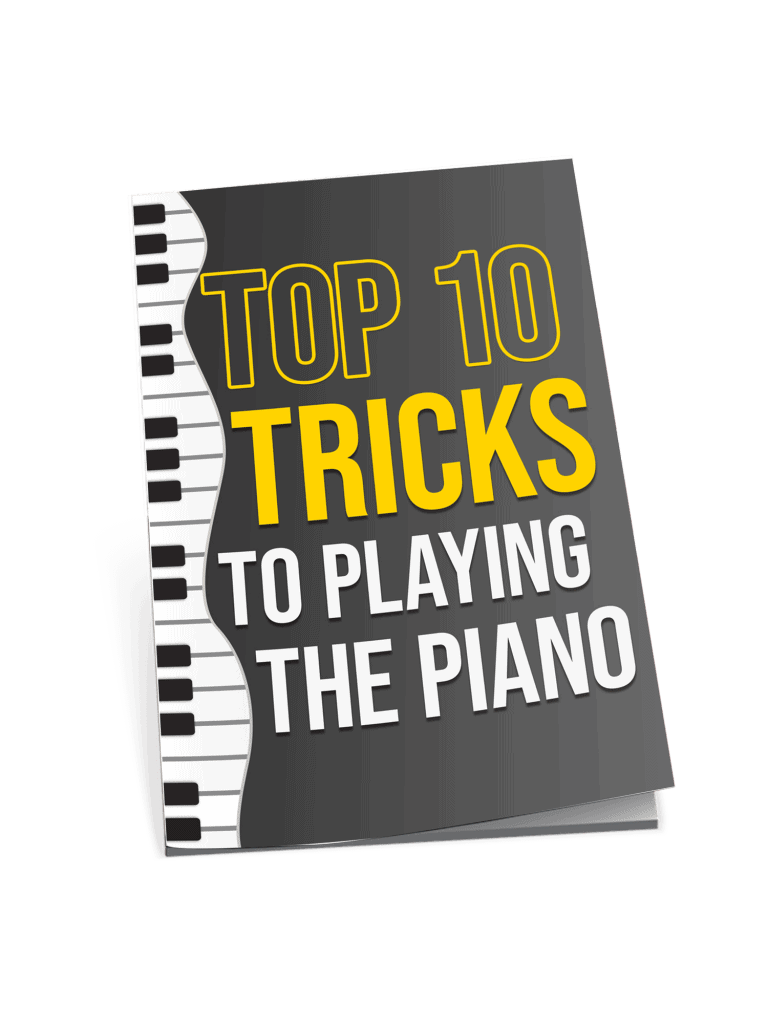
I’ve always believed in understanding the past to appreciate the present. This article serves not just as a guide to choosing between a grand or upright piano but also as a reminder of the evolution of music through these beautiful instruments. The YAMAHA recommendations echo a testament to quality and tradition.
This exploration into the characteristics that distinguish upright from grand pianos is illuminating. It’s not just the physical dimensions but the nuanced sound production that defines each type’s essence. Especially compelling is how the article navigates through the tonal quality and the tactile feedback of the instruments.
Great, just when I thought deciding between an Xbox and a PlayStation was hard, now I gotta choose between an upright and a grand piano. Guess I’ll just turn my living room into a concert hall, no biggie.
always thought pianos were kinda boring, but reading about the grand piano’s dynamics and resonance makes me wanna give it a try. maybe it’s not just for classical music buffs.
A commendable article on the nuances between upright and grand pianos. However, the mention of the damping system in grand pianos needs further elaboration regarding its impact on sound decay and quality, particularly in studio environments.
This is just what I needed! Been torn between getting an upright or a grand, and I think the benefits of the grand piano just win me over. Can’t wait to start saving up for my YAMAHA C3X PE! Thanks for the detailed comparison.
While the benefits of grand pianos are clearly highlighted, it’s essential to factor in the practicality for average users. The space and financial investment significantly outweigh the benefits unless one is a professional or aspiring musician of high caliber.
never thought a guitar guy like me would be drooling over pianos but here we are lol. those grand pianos sound epic but man, the space and the $$$. might stick to my six strings for now.
The comparison between upright and grand pianos is immensely helpful for someone like me who’s looking to purchase a few for teaching purposes. The YAMAHA u1 upright piano recommendation is particularly of interest, especially for its compact shape which is ideal for a classroom setting.
When they said grand pianos have better dynamics, I didn’t expect it to mean my wallet would feel the dynamics too. Great, now I want a grand piano and a bigger living room.